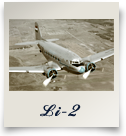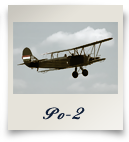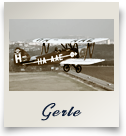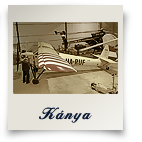
In the summer term - from June to October - we organize pleasure flights at the airport of Budaörs on the first Saturday of every month so that those who want to experience what the air transport was like in the 1950´s can try the Li-2. In the autumn of 2001 we managed to dismantle the Li-2 and transport it from the Amusement Park of Pécs to Budaörs. This plane was also repaired to be shown in the excibition of statics of the Museum of Military Aeroplanes in Szolnok so that the Museum had a military painted Li-2.
When the 'wishes and intentions' concerning the 'resurrection' of a Li-2 began to solidify into 'serious thought', the downfall of socialism was imminent, so we could count on encountering no bureaucratic interference and obstructionism.
In the process of choosing a plane for refurbishing, our thoughts first turned to a decommissioned, ex Air Force Li-2, which was exhibited in the open-air museum of the Flying Instructor Training Base at Farkashegy. She was the property of the Hungarian Museum of Transportation, we only had her on loan. Her final destination was to be exhibited at the Open Air Exhibition of historic craft at Ferihegy Airport. On closer examination we have found, that although she was supposed to be well preserved, in fact she was so badly damaged during the relocation from Budaörs to Farkashegy and by souvenir hunters, that we had to exclude her from the list of possible candidates for 'resurrection'.
The possibility of acquiring a DC-3 abroad was also examined. We located one near Wiener Neustadt, but she was too worn and damaged to be a feasible proposition for rebuilding. Another DC-3 was offered for sale in Istambul, but she was in such a neglected and 'run-down' condition (18000 hours flown and out of service for the last seven years) that her purchase, transportation from Turkey to Hungary and eventual reconditioning could not be turned into a viable economic proposition. So, considering the limits of our financial resources and the problems caused by the necessary transport over long distances, we decided to restrict our search to planes available within Hungary.
Our first step was to contact the Aviation Museum Foundation at Szolnok, and present them with the idea of rebuilding and operating the craft in their possession as a shared project. Our offer was favourably received and having obtained the necessary permits from higher authorities, the Memorandum of Co-operation was signed during the passing out ceremony at the close of the academic year. So we could start working.
The plane was dismantled in July, 1996. The transfer of the engines, the fuselage, the wings and control surfaces to Budaörs was completed within the month. The actual movement took place at night, under the guidance and supervision of the Police.
The first stage of the work was the preliminary damage assessment and the preparation of the work-plan. We predicated our plans on the assumed co-operation of the still existing Air Services Workshop, so the necessary paperwork (permints, etc.) was done in their name. We were lucky, because the original technical documentation of the plane, which was used in her 'general maintenance' by MALÉV, has been saved from destruction in 1974, so it was available.
All the metallic parts of the plane had to be stripped of their several layers of paint. This was not a small undertaking, as our plane served both in the Hungarian Air Force (painted green) and as a civilian airliner (painted silver). In addition it was used in the war-movie 'The Indictment', disguised as a Savoya Marchetti troop transporter, wearing contemporary (early WWII) paint and markings. The cleaning was accomplished in two years, using 500 litres of paint-stripper.
The repair of the structural elements and the acquisition of the new replacement parts took place simultaneously with the cleaning. The situation was complicated by the liquidation of 'Air Services Company', the original contractors. Some of their personnel organised themselves into a new company, 'PRIMEX Kft' and they agreed to inherit the job and accept the 'licence for repair', together with all the implied legal obligations. Repair work on some parts was subcontracted to 'REPSZER Kft' and 'AEROMETAL Kft'. The flexible piping was made by the 'DANUBE AIRCRAFT WORKS', and 'AEROPLEX' helped with sundry other jobs. 'MHSZ' let us have some otherwise unavailable spare parts from the stock of their stores at Budaörs. 'MALÉV' donated a 'TU-154' type radio and navigation system. Many other companies have also given significant help in the form of spare parts and materials. For example our colleague, Csaba Kornyik, formerly an aircraft mechanic, presently an entrepreneur, contributed two reconditioned AS-62 IR engines.
The news about our activities soon started to spread, in consequence of which many interested old colleagues came to visit our workshop. Several of them got involved in the project and became active participants, so our young enthusiasts could derive a direct benefit from the experience, advice and example of the old experts.
During the reconstruction most of our 'headaches' were caused not by the everyday technical problems, but by the financial worries of the day to day operation. At first the continuity of work could be maintained with the help of some already existing resources, loans from the participants and the financial support coming from 'MALÉV'. These resources were exhausted by the early days of 2001. Thereafter it was the 'SUNFLOWER' Airline Company whose support enabled us to continue and finally complete the job. The work of assembly, the replacement of the renewed and reconstructed parts, started in the Spring of 2000. There was some modification and modernisation of a few parts, and all these had to be documented, according to the existing standing instructions applicable to the industry. We solicited and complied with the guidance and supervision of the relevant authorities at every completed stage of the work.
The replacement of the complete radio-navigation system was unavoidable. The original instrumentation of the plane has, by this time, became totally obsolete, so, after dismantling, we donated it to the museum. The avionics system was replaced by the still serviceable system used by the TU-154 type ('KURSZ MP', 'DME', 'ARK-15', Baklan 20 communication equipment, 'GPS' satellite navigation system), together with the necessary connecting cables and power supplies. This part of the job and the installation of a new instrument panel was done by the firm 'SEC-AIR' Kft, under the professional guidance of György Hubbes. The passenger furniture also had to be modified. It was necessary to install new, up-to-date passenger seats with new covering fabrics, modern sound- and heat-insulation, and comfortable toilet facilities. In place of the radio-room, which has lost its function, a new galley was installed.
In the summer of 2001 the plane left her hangar. After fitting the wings, the final details, the system checks, the regulation tests, and the first engine trials were performed in the open air.
On the 21th September, as the test crew took their seats in the plane, others watched with excitement, mixed with anticipation. The stairs were removed, the door closed, the engines started and the giant bird started her dignified roll across the lawn. After a few turns and brake-tests she rolled up to the starting line. The engines' pitch changed, the plane moved, accelerated and finally... she flew.
After the easy lift-off and a circuit, she disappeared in the direction of Balatonkiliti, the designated site of the takeoff and landing tests.
In the afternoon, after the plane returned, we knew that she was good, and the hardest part of the task was behind us. WE HAD SUCCEEDED.
On the ground, champagne bottles were opened for the descending crew. They were literally soaking in the 'bubbly'.
After the last, minor adjustments, the full test-flying program sequence was completed during the Winter and Spring seasons. On the 15th April the test program was officially terminated and the plane was issued with her official 'Certificate of Airworthiness'.
.

| Technical data: | |
| Wing-span: | 28,81 m |
| Wing area: | 91,7 m2 |
| Length of the plane: | 19,65 m |
| Cabin length: | 8,45 m |
| Cabin width: | 2,34 m |
| Weight of the empty plane: | 7325 kg |
| Capacity: | 19 passengers |
| Crew /with stewardess/: |
4 persons |
| Take-off weight /passenger version/: |
10 900 kg |
| Take-off weight /cargo version/: |
11 500 kg |
| Engine trust: | 1000 LE |
| Fuel flow: | |
| 260-280 l/h | |
| Cruising speed: | |
| 240-260km/h | |
| Maximum speed /at 1000 metres/: |
316 km/h |
| Take-off length: | |
| 1000-1200m | |
| Landing distance: | 380-430m |
| Maximum distance: | 2500 km |
| Ceiling: | 6000 m |
| Climbing ability at 1000 metres: |
4,4 minutes |
| Landing speed: | 100 km/h |













